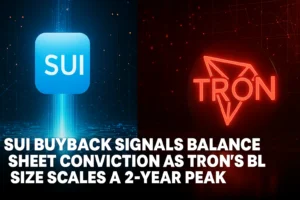21Shares Amends Sui Staking ETF for Nasdaq, Market Responds with a 2.5% Surge

The Sui trade just got a little more institutional. After the market closed on October 23, 21Shares filed Amendment No. 2 to its S-1 for the 21Shares Sui ETF, adding explicit authority to stake a portion of the trust’s SUI and confirming the Nasdaq Stock Market as the intended listing venue. The filing also spells out a cleaner operations stack, naming Coinbase Custody for digital asset safekeeping and Bank of New York Mellon for administration, transfer agency, and cash custody.
- Nasdaq Filing: Why Amended Sui ETF Matters
- The Stack: Coinbase and BNY Mellon Take Key Roles
- The Benchmark: CME CF Sui Dollar Reference Rate
- The Venue: Nasdaq, and a Paper Trail at the SEC
- Market Reaction: A Quick Pop and Rising Derivatives Interest
- What Staking in an Inside-US ETF Means
- Signals From the Street: Early Reactions
- What’s Next for Investors
- 21Shares Sui ETF at a Glance
- Conclusion
- Frequently Asked Questions about 21Shares’ Sui ETF
- Does the amended filing guarantee the Sui ETF will launch soon?
- Will the ETF always stake its SUI holdings?
- How are staking rewards handled in the fund?
- Who holds the ETF’s SUI and cash?
- Why reference a CME CF benchmark for pricing?
- Does staking change Sui’s network risk for investors?
The amended prospectus says the fund will track the CME CF Sui Dollar Reference Rate, New York Variant, and reflect staking rewards in net asset value when the sponsor determines staking is viable under legal and tax constraints. The sponsor would use third-party providers for staking, led by Coinbase Crypto Services under a two-year agreement.
Traders noticed fast. Within an hour of the headlines, SUI rose about 2.5%, while derivatives interest ticked higher, signaling fresh positioning in the news. That burst of activity followed weeks of choppy price action across majors.
This is a notable test case for staking inside a US spot crypto ETF framework. It intersects the operational realities of a Delegated Proof of Stake (DPoS) network, where validators secure the chain and share rewards with delegators, with the regulatory and tax architecture of a grantor trust. Sui uses delegated proof of stake, and the filing describes how rewards, if pursued, would accrete to NAV.
Nasdaq Filing: Why Amended Sui ETF Matters
Amendment No. 2 lays out a clear path for adding staking to the trust’s tool kit. The prospectus states the fund seeks to track SUI as measured by the CME CF Sui Dollar Reference Rate, adjusted for expenses and, at the sponsor’s discretion, to reflect rewards from staking a portion of the trust’s SUI. That language elevates staking from an idea to an articulated objective within the fund’s strategy.
The document also details how rewards would be handled. Staking proceeds would accumulate inside the trust and be reflected in NAV, rather than distributed directly to shareholders. It sets expectations on validator selection, uptime monitoring, and slashing risk, and sketches the ability to use liquid staking tokens if, and only if, the tax and regulatory analysis supports them.
For investors, the mechanics matter more than the buzz. An ETF that can earn staking rewards without taking on undue legal risk could narrow tracking error against spot holdings and marginally improve the return profile, while preserving the ETF’s operational simplicity. The sponsor would retain the latitude to pause or adjust staking if network or policy conditions change.
The Stack: Coinbase and BNY Mellon Take Key Roles
The filing names Coinbase Custody Trust Company as the SUI custodian, responsible for safekeeping the trust’s digital assets, and Bank of New York Mellon as the administrator, transfer agent, and cash custodian. This division of labor has become familiar across the digital asset ETF landscape, pairing a crypto-native custody stack with traditional fund-admin rails.
On staking, 21Shares has a Master Infrastructure-as-a-Service Agreement with Coinbase Crypto Services. Under this two-year agreement, Coinbase may operate as a public validator or a dedicated validator and would receive a low single-digit share of staking rewards as compensation. The contract can be terminated with notice, and the ETF may add other providers over time.
ALSO READ: XDC Network Unveils $10M “Surge”, Brings Real-Time Transparency to DeFi
This structure aims to align an institutional-grade operational setup with the realities of a delegated proof-of-stake chain. Validators keep Sui blocks flowing, delegators share in rewards, and the ETF functions as a professionally managed delegator that can scale, rotate, or pause based on risk.
The Benchmark: CME CF Sui Dollar Reference Rate
Pricing will key off CF Benchmarks’ Sui reference rate, a once-a-day benchmark that aggregates spot trades from constituent exchanges under a regulated methodology. The S-1 describes how the New York Variant is calculated, how constituent exchanges are selected, and how the benchmark supports daily NAV. This is the same reference-rate infrastructure used across many recent digital asset products.
CF Benchmarks maintains product pages for SUI, including real-time and reference-rate variants, which provide transparency into index rules, constituents, and oversight. That transparency has been crucial for regulatory acceptance of crypto ETFs over the last two years.
The Venue: Nasdaq, and a Paper Trail at the SEC
The amended prospectus says the shares are anticipated to list on the Nasdaq Stock Market, consistent with Nasdaq’s separate 19b-4 rule filing to list and trade the ETF under Rule 5711(d) for commodity-based trust shares. The SEC published that filing and later instituted proceedings, signaling an active review timeline.
That leaves the familiar two-track process. The registration statement governs the fund’s disclosures, while the exchange’s 19b-4 governs listing. Both must clear before trading can begin. The SEC’s Federal Register docket shows the cadence of comment windows and extensions thus far.
Market Reaction: A Quick Pop and Rising Derivatives Interest
Traders reacted to the after-hours amendment with a quick move higher in SUI. Within an hour, the Sui price gained roughly 2.5%. The pop was small in absolute terms, but it pointed to sensitivity around staking language, listing venue clarity, and the overall de-risking of ETF plumbing. Derivatives metrics showed open interest rising on the news, a common fingerprint when fast money leans into an event and hedgers adjust.
For context, CoinGlass’s dashboard shows SUI’s futures open interest and long-short balances ebbing and flowing alongside spot. The day’s uptick does not set a trend by itself, but it adds to a steadily deepening market structure for SUI across exchanges. Liquidity and borrow dynamics will matter if ETF creations and redemptions begin to touch spot order books in size.
What Staking in an Inside-US ETF Means
A spot ETF that participates in staking on a delegated proof-of-stake network pushes the market in two directions at once. First, it brings a native chain function into a familiar fund wrapper, aligning with how DPoS chains are designed to operate. Second, it tests how tax, accounting, and securities rules will treat accrual of staking rewards inside a grantor trust. The filing addresses both and leaves room to adapt.
If staking proceeds, rewards would accrete to NAV. That could help tracking when compared with holding SUI directly or through an instrument that cannot stake. The sponsor retains discretion to evaluate slashing risk, validator performance, and unbonding timelines. That is the sober middle path investors expect from a large issuer.
Sui’s network is built around delegated proof of stake. Token holders delegate to validators, validators run consensus, and rewards flow back to delegators. An ETF that delegates through a professional provider does not change the network’s economics; it participates as a large, transparent actor. That should be constructive for alignment and uptime incentives.
ALSO READ: Sui ETF Back in Limelight as Cboe Awaits SEC Decision on Canary ETF
Signals From the Street: Early Reactions
The 21Shares US account flagged the initial Sui ETF filing earlier in the cycle, framing the move as a step toward exchange-traded access. Community accounts have continued to track milestone moments, including acknowledgments of the Nasdaq process. These posts underscore demand for simple on-ramps to newer layer-1 assets.
Update: The SEC has acknowledged @Nasdaq‘s filing to list and trade shares of the @21shares_us SUI ETF on the Federal Register, formally initiating the review process for this proposed investment vehicle. https://t.co/c9zyjVmgED
— 21shares US (@21shares_us) June 10, 2025
Not every social headline is gospel, and investors should always anchor on primary sources. In this case, the substance sits in the S-1/A, the Nasdaq 19b-4, and CF Benchmarks documentation. The tweets show where attention goes, not where the law lands.
What’s Next for Investors
The next checkpoints sit on two tracks. On the disclosure side, look for any further refinements to staking language, fee details, and the final ticker. On the exchange side, watch the SEC’s order on the Nasdaq 19b-4, where the Commission can approve, disapprove, or extend the decision window again. Document cadence matters because the ETF cannot launch without both tracks green-lit.
Beyond filings, keep an eye on Sui’s on-chain and liquidity health. Delegated proof of stake concentrates network reliability in validator sets. If institutions begin delegating through an ETF, validator concentration, slashing events, and governance participation become relevant. These are normal features of DPoS networks, and they are measurable as the product scales.
21Shares Sui ETF at a Glance
| Item | Detail |
| Vehicle | 21Shares Sui ETF (grantor trust) |
| Listing venue | Nasdaq Stock Market LLC, pending 19b-4 approval (SEC) |
| Pricing benchmark | CME CF Sui Dollar Reference Rate, New York Variant |
| SUI custodian | Coinbase Custody Trust Company, LLC |
| Cash custodian | Bank of New York Mellon |
| Administrator & transfer agent | Bank of New York Mellon |
| Staking services provider | Coinbase Crypto Services, two-year agreement |
| Staking rewards treatment | Accrue to NAV at sponsor discretion, subject to risk and tax analysis |
Conclusion
The amended S-1 marks a practical step in the evolution of crypto ETFs. It keeps the plain-vanilla tracking of a spot vehicle, and it opens a pathway to capture staking rewards in a way that fits US regulatory and tax constraints. The operations stack is clear, with Coinbase on crypto infrastructure and BNY Mellon on traditional fund rails. The pricing anchor is CF Benchmarks. The venue is Nasdaq, pending the SEC’s decision on the exchange rule filing.
For investors who follow Delegated Proof of Stake (DPoS) networks, this matters. It aligns the ETF wrapper with how Sui works, without turning a fund into an experimental protocol. The sponsor keeps discretion to adjust staking in response to risks, slashing, or legal signals. The market’s quick, modest bid tells you the path to a live product with staking features is the new focus. From here, the timeline belongs to the Commission, and the playbook sits in public filings.
Frequently Asked Questions about 21Shares’ Sui ETF
Does the amended filing guarantee the Sui ETF will launch soon?
No. The ETF still needs both an effective registration statement and an approved exchange rule filing. The SEC has an active docket for the Nasdaq 19b-4.
Will the ETF always stake its SUI holdings?
Not necessarily. The sponsor has discretion to stake a portion of the trust’s SUI when it determines the legal, regulatory, and tax profile is acceptable.
How are staking rewards handled in the fund?
Rewards, if earned, would be added to the trust’s assets and reflected in NAV rather than paid out as cash to shareholders.
Who holds the ETF’s SUI and cash?
Coinbase Custody safekeeps SUI. Bank of New York Mellon serves as administrator, transfer agent, and cash custodian.
Why reference a CME CF benchmark for pricing?
CF Benchmarks provides a regulated, rules-based reference rate that aggregates eligible spot trades from constituent exchanges, supporting daily NAV calculations.
Does staking change Sui’s network risk for investors?
Staking aligns with Sui’s delegated proof-of-stake design. Operational risk remains, including validator downtime and slashing, which the sponsor addresses with provider selection and monitoring.




